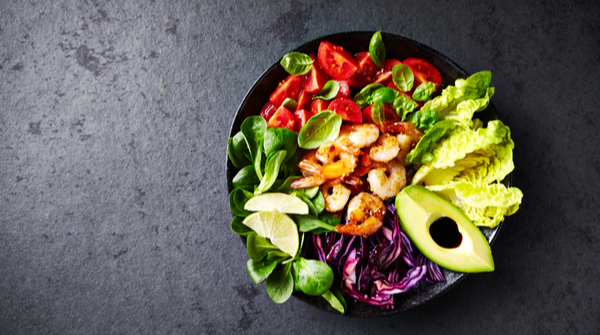When you picture yourself making healthy dietary choices, do you imagine your plate looking sad and dull? If you believe so, this article will change your idea of a healthy diet. Eating a plate full of one or two kinds of vegetables for a long time would probably fulfill your requirements for limited types of nutrients. However, your body requires a variety of nutrients in order to stay fit. So pack your plate with colors of health and boost your daily intake of important and often overlooked nutrients.

With the typical choices of fruits and vegetables available in markets, eat all of the colors of the rainbow. This will help you obtain the broadest range of vitamins, nutrients, and fiber. These colors signify the presence of diverse phytochemicals and phytonutrients.Phytochemicals and phytonutrients are substances produced by plants. People who eat diets rich in phytonutrients have diverse health benefits.
Introduce These Colors of Health to Your Diet

Purple and Blue
Blue and purple fruits and vegetables contain the plant pigment anthocyanin. Anthocyanins have antioxidant properties that help limit damage caused to your cells. It may also lower your risk for heart disease, stroke, cancer, and memory problems. Moreover, these vibrant fruits and vegetables are rich in vitamin A, vitamin C, potassium, and folate. They help minimise the risk of urinary tract infections and keep your immune system healthy as well.
| FRUITS | VEGETABLES |
| Blackberries | Purple Cabbage |
| Blueberries | Purple Carrots |
| Black Currants | Eggplant |
| Dried Plums | Purple Peppers |
| Grapes | Purple Potatoes |
| Plums |
Green
Chlorophyll is what gives green fruits and vegetables their distinctive color. Some of them contain indoles and saponins, which are known to reduce the risk of cancer, and lutein, which prevents sight problems. Also, leafy greens such as spinach and broccoli are excellent sources of folate, which is good for your eyes, bones, and teeth.
Green fruits also help lower the risk of developing age-related macular degeneration. The essential nutrients found in green vegetables and fruits protect you from high levels of bad cholesterol, regulate digestion and improve immune system functioning.
| FRUITS | VEGETABLES |
| Avocados | Broccoli |
| Green Apples | Brussels Sprouts |
| Grapes | Chinese Cabbage |
| Kiwifruit | Green Beans |
| Limes | Cabbage |
| Green Pears | Celery |
| Cucumbers | |
| Leafy Greens | |
| Green Onions | |
| Okra | |
| Peas | |
| Green Peppers | |
| Spinach | |
| Zucchini |
Yellow and Orange
The yellow/orange group of fruits and vegetables has carotenoids in them. A known Carotenoid, beta carotene, is found in many yellow vegetables such as sweet potatoes, pumpkins, and carrots that get converted into Vitamin A. However, this does not just help to maintain healthy mucous membranes and healthy eyes but also helps to keep your skin, teeth, and bones healthy.
Citrus fruits contain a unique phytonutrient called hesperidin, which helps to increase blood flow in the body. This has significant health ramifications. So if you tend to get cold hands and feet, eat an orange every day to keep them warm.
| FRUITS | VEGETABLES |
| Apricots | Yellow Beets |
| Cantaloupe | Carrots |
| Grapefruit | Yellow Peppers |
| Lemons | Yellow Potatoes |
| Mangoes | Pumpkin |
| Oranges | Yellow Summer Squash |
| Papayas | Sweet Corn |
| Peaches | Sweet Potatoes |
| Yellow Pears | Yellow Tomatoes |
Red
Red vegetables and fruits often contain a natural plant pigment known as lycopene. Lycopene is a powerful antioxidant that helps prevent heart problems and reduces the risk of cancer. A small to medium raw tomato contains 3.2 micrograms of lycopene. Although there is no set daily value for lycopene, consuming 2 to 30 milligrams per day is generally recommended.
| FRUITS | VEGETABLES |
| Red Apples | Beets |
| Cherries | Red Peppers |
| Cranberries | Radishes |
| Red Grapes | Red Onions |
| Pomegranates | Tomatoes |
| Raspberries | |
| Strawberries | |
| Watermelon |
Brown/White
The white fruits and vegetables we consume are known to have a range of health-promoting phytochemicals in them. One such phytochemical is allicin, which is present in garlic and contains antiviral and antibacterial properties. Some fruits and vegetables of the white group, such as potatoes and bananas, are a good source of potassium, which is good for lowering blood pressure and maintaining the balance of acids and bases in the body.
| FRUITS | VEGETABLES |
| Bananas | Cauliflower |
| Dates | Fennels |
| White Peaches | Garlic |
| Coconuts | Ginger |
| Mushrooms | |
| Onions | |
| Turnips | |
| White Potatoes | |
| White Corn |
Read More: 10 Diabetes-friendly Fruits To Keep Your Blood Sugar In Control
All fruits and vegetables have a distinctive colour indicating different nutrient profiles. Therefore, it is necessary to focus on getting a little of each colour in your diet every day to maximise the nutritional benefits. Choose #ColorsOfHealth to lead a happy and healthy life.
Download the BeatO App and connect with BeatO Health Coaches to get your personalised diet plan.




